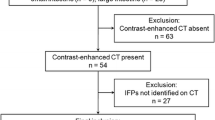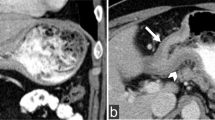Abstract
Purpose
To analyze the features of gastrointestinal linitis plastica obtained by computed tomography (CT).
Materials and methods
We conducted a single-center, retrospective analysis of 45 cases of gastrointestinal tract linitis plastica collected over a 10-year period. “Linitis plastica” was defined based on histological characteristics. Primary and secondary linitis plastica were included. Two readers independently assessed the radiological findings (i.e., number of lesions, mass, wall thickening, and enhancement).
Results
The patient cohort comprised 23 men and 22 women with an average age of 63.2 years. The main presenting signs and symptoms were impaired general health and ascites (22/45 patients, 48.8%). The stomach was the affected organ in 68.3% of the cases, while the rectum was affected in 11.7% of the cases. Primary linitis was found in 73.3% of the cases, and solitary lesions were found in 77.8% of the cases. The most common CT finding was wall thickening (91.7%) with a complete disappearance of folds and enhancement of the entire wall at 2 min. Four lesions (6.6%) were described as masses, and only one (1.7%) was described as a wall atrophy.
Conclusion
Linitis plastica can affect the entire digestive system. Its potentially secondary nature necessitates a systematic search for a primary tumor. An appropriate CT protocol is required to detect the specific radiological features of this fibrous cancer. CT can help confirm the diagnosis of linitis plastica, rule out differential diagnoses, and indicate the need for deep biopsies where possible.






Similar content being viewed by others
References
Brinton W (1859) The diseases of the stomach with an introduction on its anatomy and physiology. London: J. Churchill, p 310
Borrmann R (1926) Geschwülste des Magens und Duodenums. In: Borchardt H, Borrmann R, Christeller E, Dietrich A, Fischer W, Von Gierke E, et al. (eds) Verdauungsschlauch. Berlin: Springer, pp 812–1054
Aaltonen LA, Hamilton SR (eds) (2000) Pathology and genetics of tumours of the digestive system, vol. 38. Lyon: IARC Press
An JY, Kang TH, Choi MG, et al. (2008) Borrmann type IV: an independent prognostic factor for survival in gastric cancer. J Gastrointest Surg 12:1364–1369
Piessen G, Messager M, Leteurtre E, Jean-Pierre T, Mariette C (2009) Signet ring cell histology is an independent predictor of poor prognosis in gastric adenocarcinoma regardless of tumoral clinical presentation. Ann Surg 250:878–887
Park MS, Ha HK, Choi BS, et al. (2004) Scirrhous gastric carcinoma: endoscopy versus upper gastrointestinal radiography. Radiology 231:421–426
Kanter MA, Isaacson NH, Knoll SM, Nochomovitz LE (1986) The diagnostic challenge of metastatic linitis plastica. Two cases and a consideration of the problem. Am Surgeon 52:510–513
Nguyen MD, Plasil B, Wen P, Frankel WL (2006) Mucin profiles in signet-ring cell carcinoma. Arch Pathol Lab Med 130:799–804
Insko EK, Levine MS, Birnbaum BA, Jacobs JE (2003) Benign and malignant lesions of the stomach: evaluation of CT criteria for differentiation. Radiology 228:166–171
Macari M, Balthazar EJ (2001) CT of bowel wall thickening: significance and pitfalls of interpretation. Am J Roentgenol 176:1105–1116
Kim DY, Kim HR, Kim YJ, Kim S (2002) Clinicopathological features of patients with Borrmann type IV gastric carcinoma. ANZ J Surg 72:739–742
Li C, Kim S, Lai JF, et al. (2007) Advanced gastric carcinoma with signet ring cell histology. Oncology 72:64–68
Levine MS, Kong V, Rubesin SE, Laufer I, Herlinger H (1990) Scirrhous carcinoma of the stomach: radiologic and endoscopic diagnosis. Radiology 175:151–154
Koufuji K, Aoyagi K, Yano S, et al. (2005) Peritoneal dissemination of scirrhous type 4 gastric cancers. Cancer Chemother 32:1384–1388
Schauer M, Peiper M, Theisen J, Knoefel W (2011) Prognostic factors in patients with diffuse type gastric cancer (linitis plastica) after operative treatment. Eur J Med Res 16:29–33
Kim JI, Kim YH, Lee KH, et al. (2013) Type-specific diagnosis and evaluation of longitudinal tumor extent of Borrmann type IV gastric cancer: CT versus gastroscopy. Korean J Radiol 14:597–606
Otsuji E, Kuriu Y, Okamoto K, et al. (2004) Outcome of surgical treatment for patients with scirrhous carcinoma of the stomach. Am J Surg 188:327–332
Kong X, Wang JL, Chen HM, Fang JY (2012) Comparison of the clinicopathological characteristics of young and elderly patients with gastric carcinoma: a meta analysis. J Surg Oncol 106:346–352
Beyrouti MI, Beyrouti R, Amar MB, et al. (2007) Linite plastique gastrique. Presse Med 36:1782–1786
Dixon CF, Stevens G (1936) Carcinoma of linitis plastica type involving the intestine. Ann Surg 103:263–272
Ha HK, Jee KR, Yu E, et al. (2000) CT features of metastatic linitis plastica to the rectum in patients with peritoneal carcinomatosis. Am J Roentgenol 174:463–466
Rubesin SE, Levine MS, Laufer I (2008) Double-contrast upper gastrointestinal radiography: a pattern approach for diseases of the stomach. Radiology 246:33–48
Guermazi A, Brice P, de Kerviler EE, et al. (2001) Extranodal Hodgkin disease: spectrum of disease. Radiographics 21:161–179
Régent D, Laurent V, Antunes L, et al. (2002) Fibrous tissue(s): a key for lesion characterization in digestive diseases. J Radiol 83:292–312
Ba-Ssalamah A, Prokop M, Uffmann M, et al. (2003) Dedicated multidetector CT of the stomach: spectrum of diseases. Radiographics 23:625–644
Horton KM, Fishman EK (2003) Current role of CT in imaging of the stomach. Radiographics 23:75–87
Pickhardt PJ, Kim DH, Menias CO, et al. (2007) Evaluation of submucosal lesions of the large intestine: part 1. Neoplasms. Radiographics 27:1681–1692
Macari M, Megibow AJ, Balthazar EJ (2007) A pattern approach to the abnormal small bowel: observations at MDCT and CT enterography. Am J Roentgenol 188:1344–1355
Fernandes T, Oliveira MI, Castro R, et al. (2014) Bowel wall thickening at CT: simplifying the diagnosis. Insights Imaging 5:195–208
Hristova L, Soyer P, Hoeffel C, et al. (2013) Colorectal cancer in inflammatory bowel diseases: CT features with pathological correlation. Abdom Imaging 38:421–435
Author information
Authors and Affiliations
Corresponding author
Ethics declarations
Conflict of interest
The authors declare that they have no conflict of interest.
Ethical approval
All procedures performed in this study involving human participants were in accordance with the ethical standards of the institutional and/or national research committee and with the 1964 Helsinki declaration and its later amendments or comparable ethical standards. This article does not contain any studies with animals performed by any of the authors.
Informed consent
The Institutional review board approved the study and did not require additional informed consent for reviewing the patients’ medical records and images.
Appendix: The form used for CT interpretation
Appendix: The form used for CT interpretation
Qualitative analysis
Presence of individual features (Y/N):
A. Positive diagnosis: lesion features
-
a.
Mass syndrome,
-
b.
Gut wall thickening (stomach, >5 mm; small intestine, colon, or anus, >3 mm):
-
i.
Segmental (<100-mm-long) or diffuse,
-
ii.
Circumferential,
-
iii.
Stenotic,
-
iv.
Beyond the serous, and
-
v.
Disappearance of folds; and
-
i.
-
c.
Wall atrophy (<1 mm).
B. Qualitative analysis of lesion enhancement:
-
a.
No enhancement,
-
b.
Early arterial enhancement (A) of the mucosal-submucosal complex (two innermost layers of the gastrointestinal wall), and
-
c.
Delayed enhancement (T) of the whole lesion suggesting “fibrous” type tissue.
Quantitative analysis
Where possible
-
A.
Masses: two maximal orthogonal dimensions in the axial plane (mm);
-
B.
Wall thickening: maximum thickness (mm);
-
C.
Segmental thickening: maximum length (in mm);
-
D.
Density before injection (HU); and
-
E.
Density in the delayed portal, post-equilibrium phase (HU).
Rights and permissions
About this article
Cite this article
Burgain, C., Germain, A., Bastien, C. et al. Computed tomography features of gastrointestinal linitis plastica: spectrum of findings in early and delayed phase imaging. Abdom Radiol 41, 1370–1377 (2016). https://doi.org/10.1007/s00261-016-0652-8
Published:
Issue Date:
DOI: https://doi.org/10.1007/s00261-016-0652-8




